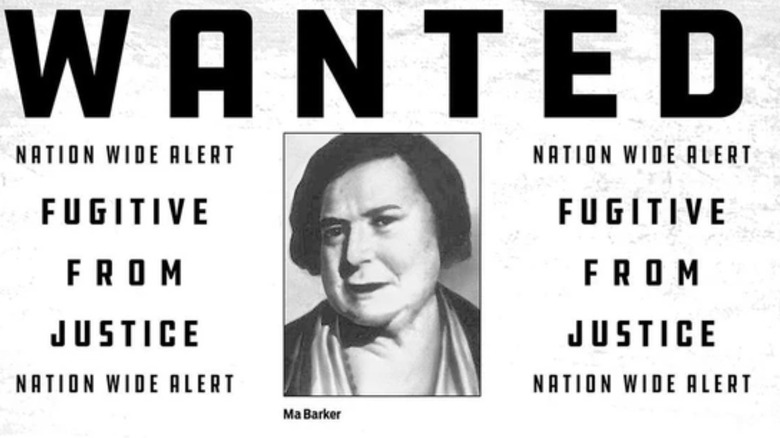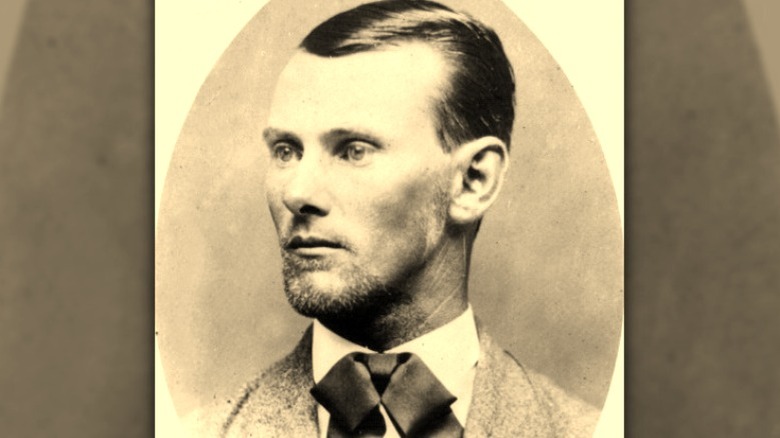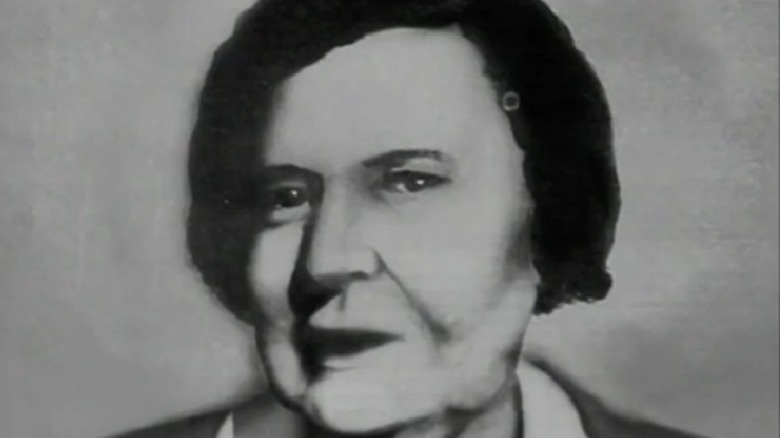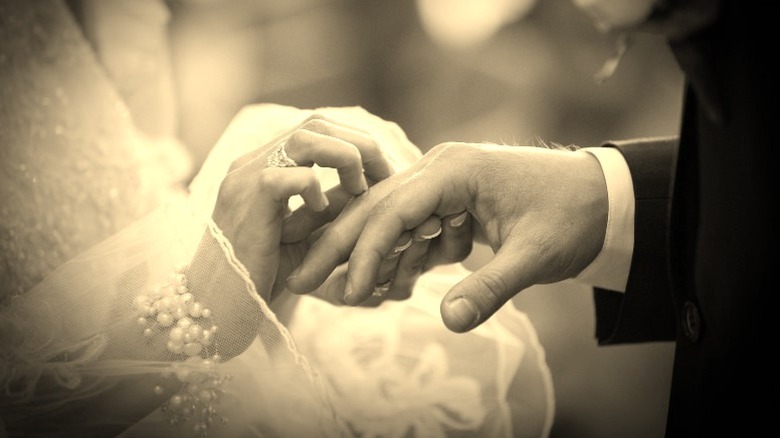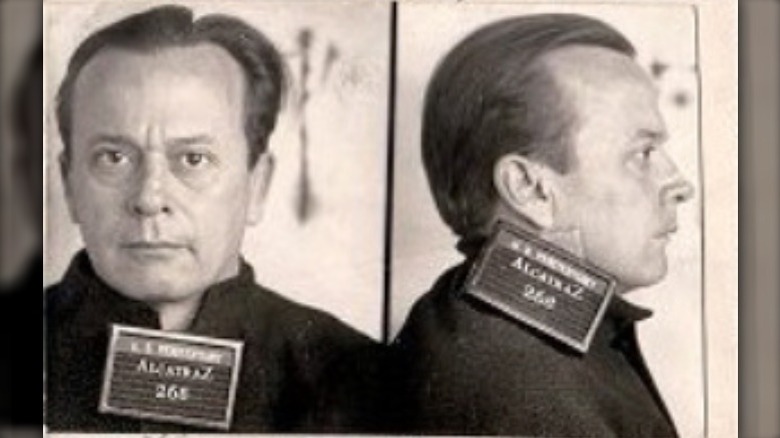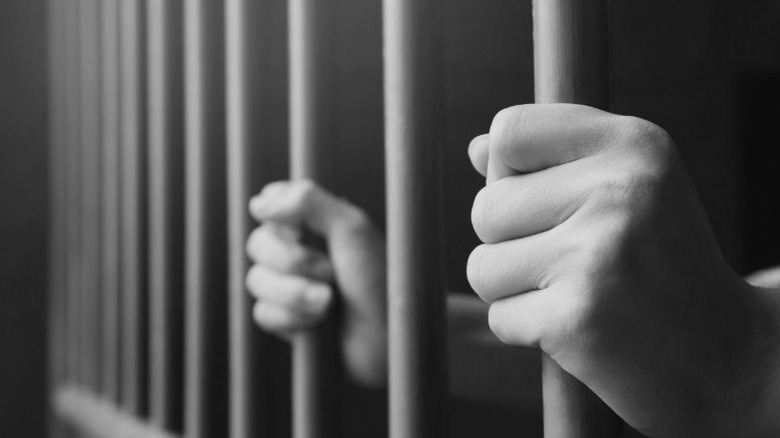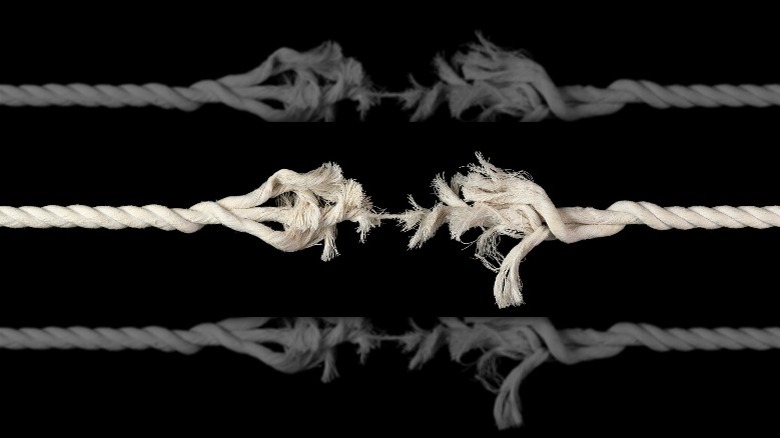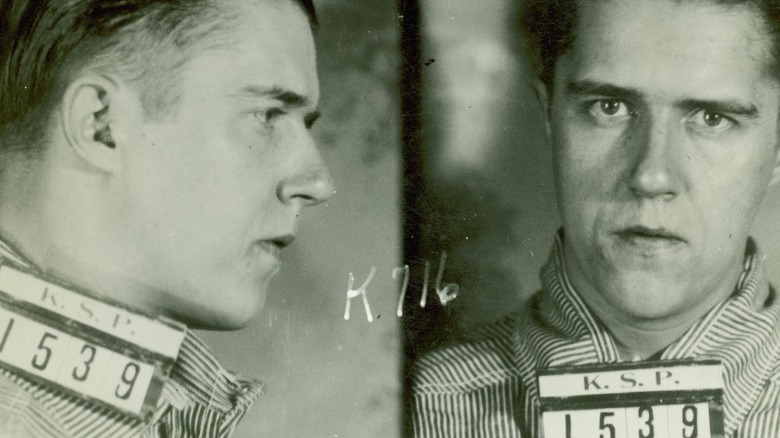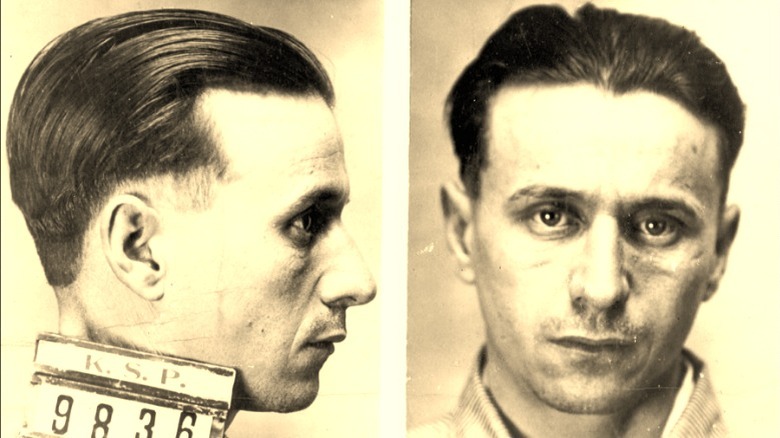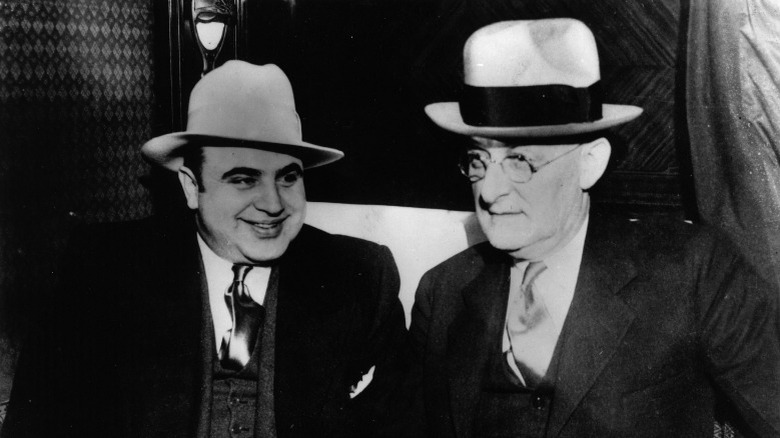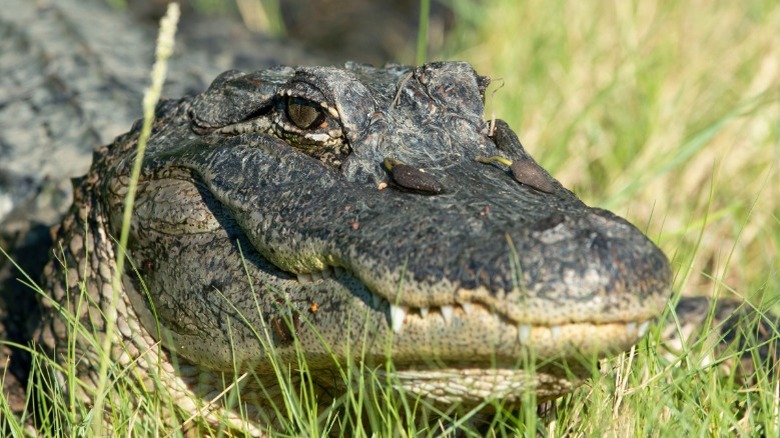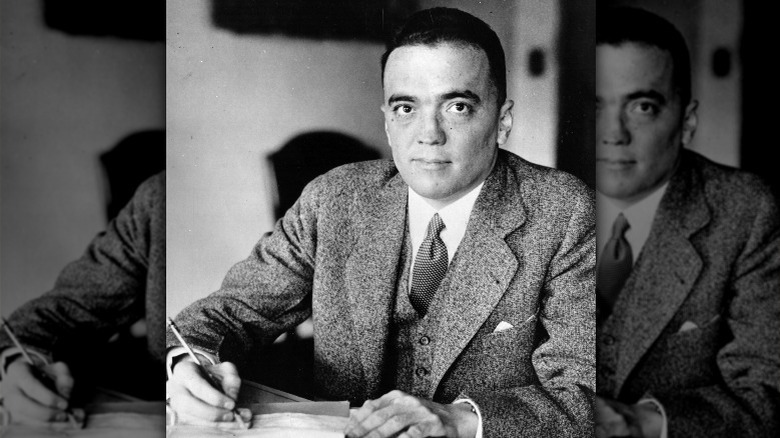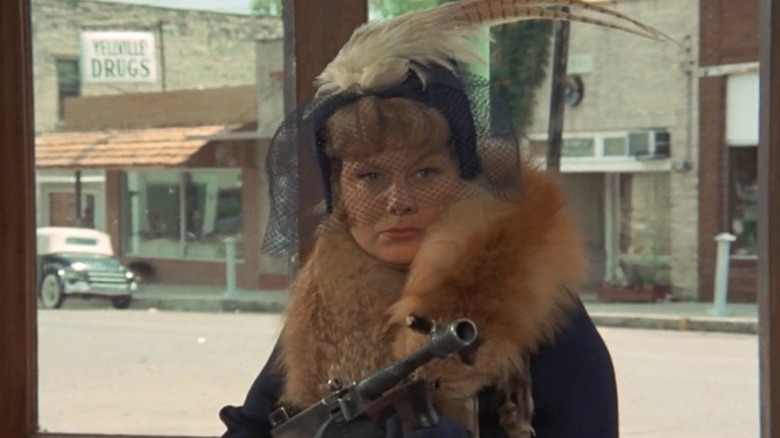The Wild Real-Life Story Of Ma Barker
Ma Barker was born on October 8, 1873, deep in the Missouri Ozarks in a town that was barely a town called Ash Grove. At birth, she was given the name Arizona Donnie Clark, as per Biography. She never much cared for the name, though, and changed it to Kate herself, notes Chris Enss and Howard Kazanjian in "Ma Barker." Of course, people don't get to choose their own names any more than they can choose their deaths or the legacy left behind. The tumultuous life of Kate Clark -– simple farm girl turned gangster matriarch -– is a lesson in this inevitability.
History remembers her as Ma Barker: the ruthless mother of four of the nation's most dangerous Depression-era criminals. Some say she was no more than a common hillbilly woman, others claim she was the mastermind of the entire Barker-Karpis Gang, who stole more money than John Dillinger, Bonnie and Clyde, and Vern Miller combined, notes author Chris Enss — and left a trail of nearly a dozen dead law enforcement officers in their wake.
No matter what version of the tale you believe, one thing is certain: Being a devoted mother was by far her most defining characteristic. But who was this woman, mostly known these days only by a single black-and -white photo reminiscent of a smirking, backwoods Mona Lisa? Let's take a trip back in time to the very wild real-life story of Ma Barker.
Outlaw Jesse James Was Her Childhood Hero
Kate Barker's parents, Emeline and John Clark, were Scottish-Irish immigrants just trying to work their small farm and make ends meet, according to authors Chris Enss and Howard Kazanjian in their book "Ma Barker," Kate adored her father, but he died when she was just 7, and her mother remarried. Her stepdad, Reuben Reynolds, was a lawman who Kate did not get along with one bit. She felt he treated her and her three siblings worse than his two biological children. This theme of persecution and injustice would permeate her life.
Already a rebellious child, young Kate became enamored with the Midwest outlaws of the time. She would steal away in her room and read magazine articles detailing the exploits of the bank and train robbing Dalton Gang. Historian and author John Koblas declared (via Press), "You can't talk about Ma Barker without talking about Jesse James."
James and his brothers had begun robbing banks throughout Missouri and made regular national news throughout her childhood. According to Biography, he and his gang even rode through her hometown during a getaway, and the sight ignited her desire for adventure. She was devastated when he was killed in 1882 (per the Orlando Sentinel). Most viewed outlaws with fear, but to many poor folks they represented the idea of the commoner taking a piece of the pie, and they became underdog heroes (via Mental Floss).
She Had a Fiery Personality
The red-haired, plump Kate Barker was always something of a spitfire. Although she stood only 5-feet 4-inches tall, notes Chris Enss and Howard Kazanjian in "Ma Barker," she made a lasting impression on those who met her.
According to Biography, she had quite the temper and was rather stubborn. Edna Murray — the girlfriend of gangster Everett "Curly" Davis of Dillinger Gang fame — wrote in Startling Detective Adventures Magazine that the men of the gang always followed Barker's orders. According to historian Courtney Ryley Cooper, she had strong features, with eyes that showed both her intelligence and cold heart. "[She was] queerly able to present the appearance of a mild, even-tempered lady," Cooper added. FBI leader J. Edgar Hoover agreed, revealing to the public in 1935 that her eyes were "queerly direct, penetrating, with some strongly smoldering flame, yet withal as hypnotically cold as the muzzle of a gun."
Barker-Karpis Gang member Alvin Karpis — who knew her quite well — paints a different picture, describing her as "an old-fashioned homebody from the Ozarks... superstitious, gullible, simple, cantankerous, and, well, generally law-abiding" (via the Toronto Sun).
Her Husband Was Her Opposite
On September 14, 1892, 18-year-old Kate Clark married George Barker, 10 years her senior, which was concerning to her parents. Of course, this only made her more eager to do it, notes Chris Enss and Howard Kazanjian in "Ma Barker."
George was employed as a farmer at the time, but young Kate saw the promise of wealth if she stuck with him. Short, blue-eyed, and dark-featured, George was quiet, as per Biography, and lacked the ambition Kate wanted, allowing her to dominate the relationship, notes the Kansas City Star.
In an FBI document, J. Edgar Hoover described George as lacking motivation. This was hardly fair. Over the years, George held several steady albeit low-paying jobs, primarily farming corn and beans and working in local mines. The couple's first home, described by authors Chris Enss and Howard Kazanjian as "a dilapidated miner's shack," was hardly the life of luxury Kate longed for but George promised he'd build it up into a great homestead.
The pair had their first son, Herman, in 1894 (per Enss and Kazanjian in "Ma Barker"). He soon had three little brothers: Lloyd was born in 1896, Arthur (nicknamed "Doc") in 1899, and Fred in 1903. According to Enss and Kazanjian, Kate handled the boys while George worked, although he managed to take them fishing and teach them how to shoot. Over the course of their marriage, George worked various odd jobs, including at the Crystal Springs Water Company (per The Famous People). But it was never enough for Kate.
She Refused to Discipline Her Sons
According to Chris Enss and Howard Kazanjian in "Ma Barker," Ma Barker attended church every Sunday and took her boys with her. She carried a Bible or hymnal with her at all times. Anytime a revival came through town she went. Nonetheless, her boys, described by the FBI as mostly illiterate, ran wild.
The troubles started small -– rocks thrown through windows, wallets stolen from pockets at church -– but soon escalated to greater and greater misdeeds. George Barker wanted to admonish his sons, but, per Enss and Kajanjian, Kate wouldn't allow it. According to Biography, Kate would become furious at the mention of discipline. Per the Joplin Globe, the Barker boys were known as the town criminals while still school-aged.
In 1910, per The Famous People, teenage Herman Barker ran over a child while fleeing the scene of a robbery in a getaway car, and the Barkers became constantly involved with the police. Kate maintained their innocence, even telling a police chief, "all these boys would be good if you cops would just let them alone."
Kate never punished her sons because she never believed they had done anything wrong. Author John Koblas (via Press) attributes this to her idolization of outlaws like Jesse James –- she had taught her sons that criminals were heroes and getting out of trouble was an easy fix. J. Edgar Hoover also attributed Kate's sons' rampant criminal activities later in life to her spoiling them.
She May Have Helped with a Jailbreak
All four of Kate Barker's sons spent a good amount of time incarcerated throughout their lives. She used every trick in the books to get her sons out of jail. According to Chris Enss and Howard Kazanjian in their book, "Ma Barker," she would yell, cry, write letters to parole boards, or, as J. Edgar Hoover alleges, bribe the police to destroy evidence. These grand gestures were often successful in getting sentences terminated -– or at least greatly reduced.
In 1918, Arthur Barker and his associates stole a few cars. He was arrested and locked up in the Tulsa County Jail. On February 14, 1920, there was a jailbreak. According to Enss and Kazanjian, a group of prisoners, including Arthur, had used a small saw and sulfuric acid to break down the bars of their cell. They climbed to the roof, where, miraculously, a rope of perfect length was waiting for them. Some historians believe Kate Barker was involved, likely providing the instruments of escape. She had conveniently visited her son in jail only a short time before his escape.
Her Husband Left Her
According to Chris Enss and Howard Kazanjian in their book "Ma Barker," the family moved to Tulsa, Oklahoma, for a fresh start, but the troubles with the law only increased. Their sons joined the Central Park Gang and began committing more serious crimes. Among the four of them, between 1915 and 1927, they were arrested for robbery, stealing cars, and even murder, as per History. Most notably, in 1927, Herman Barker killed a sheriff deputy who had witnessed him cashing stolen bank bonds (per ZMAN Magazine). He got away with it for almost a month before a cop finally caught up with him. To avoid capture, he took his own life. As the legend goes, his last words before he pulled the trigger were, "forgive me, Ma," notes Judith A. Yates in "Put the Money in My Purse!"
This tragedy took a toll on both Kate and George Barker -– but they handled it differently. Kate continued to encourage the boys' participation in crime and, according to the Joplin Globe, their family home became a gathering place for criminals. Kate enjoyed the mingling a little too much, and the FBI alleges she cheated on her husband and frequented speakeasies and nightclubs with questionable individuals who showered her with gifts.
Whether due to Kate's unfaithfulness, sadness over his son's death, or simply to escape the rampant crime, George left Kate around 1928 and moved to Joplin, Missouri, to run a gas station (per Enss and Kazanjian). He never came back.
Was she a criminal mastermind?
While her sons were known criminals, the jury is still out on Kate Barker. There is no evidence that she was ever anything more than a glorified accomplice. According to authors Chris Enss and Howard Kazanjian in their book "Ma Barker," she was never arrested in connection with a crime.
Gang member Alvin Karpis claims Barker wasn't a real criminal. "It's no insult to Ma's memory that she just didn't have the know-how to direct us on a robbery," he wrote in his memoirs (via Crime and Investigation). "We'd leave her at home when we were arranging a job, or we'd send her to a movie. Ma saw a lot of movies." Harvey Bailey, another gangster who knew Barker, put it far less delicately in his autobiography (via Alcatraz History), noting that she "couldn't plan breakfast."
While she didn't do any of the heavy lifting, Kate still had a role in the gang's activities. She held at least five different aliases over the years and may have helped stash goods, launder money, and, per the Orlando Sentinel, case banks. According to Karpis (per Crime and Investigation), her motherly persona was a huge asset. "When we traveled together, we moved as a mother and her sons," he said. "What could look more innocent?"
Her Favorite Son Got Rid of Her Boyfriend
From 1927 to 1930, Kate Barker lived alone in what author Tim Mahoney describes in his book "Secret Partners" as a "dirt-floor shack" in Tulsa, Oklahoma. She had no job, all her sons were in jail, and her husband was gone.
According to the Ma Barker House, in 1930, she met a well-dressed -– though unemployed –- older gentleman named Arthur Dunlop, and he moved in with her. Shortly after, Fred Barker was released from prison in 1931 and, per Biography, brought home a friend: former cellmate Alvin Karpis. This pairing formed the heart of what would become the Barker-Karpis Gang.
According to Karpiss (per Chris Enss and Howard Kazanjian's book "Ma Barker"), Kate allowed Dunlop to "sponge off of her" and was a "pain in the ass." He was also a heavy drinker who liked to talk, notes the Ma Barker House. When the gang's hideout was nearly discovered, the FBI alleges Fred Barker and Karpis figured he had tipped off the police -– intentionally or accidentally –- and decided to dispose of him. According to Karpis (per Mahoney), they told Kate they had sent him to Chicago with some money, but really they had paid fellow mobster Jack Peifer to shoot him, writes Judith A. Thompson in "The Hunt for the Last Public Enemy in Northeastern Ohio." In 1932, Dunlop's naked body was found by a lake in Wisconsin, killed by three bullets fired at close range, as per the FBI.
She Partied with Top Mobsters
In late 1931, per Biography, Fred Barker and his new partner in crime, Alvin Karpis, robbed a store in West Plains, Missouri, and killed a sheriff. As a result, Kate Barker became a wanted woman, and a poster with her photo offered a $100 award for her capture (per Mark Muncy and Kari Schultz in their book, "Freaky Florida"). The fuzz was hot on their tail, and it was time to find a place to hunker down for a while.
In the late 1920s and early 1930s, St. Paul, Minnesota, was just that place. According to MinnPost, there was a general understanding in St. Paul that gangsters were safe –- so long as they laid low within city limits. This was because the local police were in on the action, often tipping criminals off when the FBI was onto them. In those days, it wasn't uncommon to run into Al Capone himself at the local pub.
While in St. Paul, Kate and her boys frequented the Green Lantern Saloon, writes Chris Enss and Howard Kazanjian in "Ma Barker." On New Year's Eve, there was a gala attended by many top mobsters, including Capone's associates and Isadore "Kid Cann" Blumenfeld (per author Troy Taylor). According to Julie Thompson's "Hunt for the Last Public Enemy in Northeastern Ohio," many historians believe this party was key to the Barker-Karpis Gang's transition into a big-league crime outfit. Karpis and Fred were rubbing shoulders with the best in the business, exchanging information. In his memoirs ("Ma Barker"), Karpis claimed, "there was probably never before as complete a gathering of criminals in one room in the United States as there was on New Year's Eve in 1931."
She Enjoyed the Spoils of Her Sons' Atrocious Acts
Fred and Arthur Barker, along with Alvin Karpis, robbed a string of banks across the Midwest in 1932 (per Biography), resulting in the killings of more officers and a civilian (via MinnPost). The Barker-Karpis Gang was quickly becoming one of the deadliest criminal acts in the United States.
By 1933, they had graduated to the big leagues: kidnapping the wealthy. In June, the Barker-Karpis Gang abducted William Hamm Jr., president of the Hamm Brewery Company, demanding a hefty ransom for his release. This was a success, earning them $100,000. One year later, the gang kidnapped Edward George Bremer Jr., the president of Commercial State Bank. They pulled the same trick, this time bringing in $200,000.
While there is no evidence she was directly involved in the kidnappings, Kate "Ma" Barker certainly enjoyed the spoils. According to an FBI report, she enjoyed the life of luxury and bought expensive clothes and furniture. She gladly received all the ill-gotten gifts her boys bought her, including fur coats, jewelry, and silverware, notes Chris Enss and Howard Kazanjian in "Ma Barker." And, of course, she also enjoyed the improved living conditions wealth allowed. While the rest of the U.S. was scraping pennies in a severe economic depression, Kate was frequenting high-class restaurants and nightclubs. The riches she had always hoped her husband would bring her were now hers by way of her sons.
An Alligator Was Her Undoing
By 1935, the FBI was after the Barker-Karpis Gang. Having already captured the era's other public enemies, they were devoting all their energy to bringing in the "Bloody Barkers" and Alvin "Creepy" Karpis. The gang split up and went into hiding.
On January 8, they caught up to Arthur Barker in Chicago and arrested him (per the FBI). A search of his apartment revealed a map of Florida and a partially burned letter that mentioned a man-eating local alligator named "Old Joe." The FBI used these clues to find a lake in Florida that boasted just such an alligator. It turned out, Kate Barker and son Fred Barker were shacking up at a cottage on Lake Weir and having the time of their lives trolling for the three-legged monster, as per "Ma Barker," by Chris Enss and Howard Kazanjian and had written to Arthur telling him all about it. Unfortunately, this odd tidbit led the G-Men right to their doorstep.
According to Biography, on the morning of January 16, the Feds surrounded the house and demanded Ma and Fred surrender. But Fred stuck a machine gun out the window instead. A four-hour shootout –- the longest in FBI history, notes the Orlando Sentinel –- ensued and at the end of it, both Ma and Fred were dead.
J. Edgar Hoover Likely Invented Her Persona
According to J. Edgar Hoover's FBI report, Kate "Ma" Barker fought to her death and was found with a spent Tommy gun near her hand. But various details don't add up. For one, the first photograph taken at the crime scene doesn't depict her with a gun. For another, few believe the short, elderly Barker was capable of firing -– or even holding -– a machine gun.
But Hoover went straight to the press, describing Barker as a "she-wolf" who was "the most vicious, dangerous, and resourceful criminal brain of the last decade," notes "Ma Barker," by Chris Enss and Howard Kazanjian. According to the Washington Post, many historians believe he was saving face, justifying the killing of an unarmed old woman after the accidental death of a civilian during the John Dillinger bust.
Alvin Karpis, thought to be the true leader of the gang, disagreed with Hoover. "The most ridiculous story in the annals of crime is that Ma Barker was the mastermind behind the Barker-Karpis Gang," he said in a 1979 interview (via Toronto Sun). He added, "she wasn't a leader of criminals or even a criminal herself."
Based on the lack of evidence tying her to any crime, most historians agree with Karpis. Had she lived she likely would have been simply been charged with accessory and harboring fugitives.
Ma Barker's Legacy Lives On
Ma Barker has inspired many films, comic books, and even songs over the years. Actress Shelley Winters played a villainous fictionalized version of her in the 1966 "Batman" television series, as well as 1970's "Bloody Mama," which also starred a young Robert DeNiro as Lloyd Barker. More recently, she inspired the characters of Ma Beagle in the original animated series DuckTales and Mama Fratelli in 1985's "The Goonies," as per Crime and Investigation.
In 1977, the disco band Boney M released the danceable song "Ma Baker," which features lyrics based on her life. The song opens with a drawly country woman saying, "Freeze! I'm Ma Baker. Put yer hands in the air and gimme all yer money," before going on to describe her as "the meanest cat from ol' Chicago town." If that doesn't sound familiar, Lady Gaga later sampled the song in "Poker Face" –- those famous "ma ma ma ma's" are referencing the one and only Ma Barker.
In 2016, the Florida house where she died was relocated via barge to Carney Island and is now a museum, complete with the original furniture and bullet holes. Prior to the move, her ghost was said to haunt the house, as per the Tampa Bay Times.
Following their public display, the bodies of Fred and Ma Barker went unclaimed for nine months before George Barker finally took them home to Oklahoma to be buried next to Herman Barker, per the Joplin Globe. The first word of her simple, unassuming grave marker reads: "Ma."
